Elizabeth Stewart's Blog, page 2
August 10, 2025
Spangler: A Santa Barbara Artist by Penny Paine
Author Penny Paine talks about her latest book, Spangler: A Santa Barbara Artist, about Dennis Spangler (1953-2016).
Watch Video
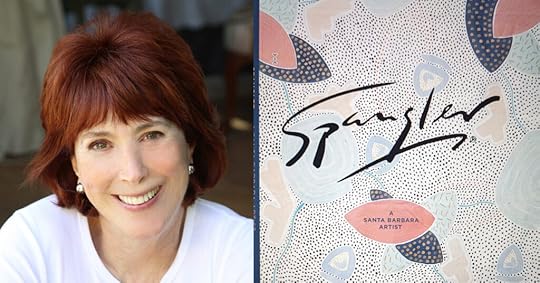
The post Spangler: A Santa Barbara Artist by Penny Paine appeared first on Elizabeth Appraisals.
August 5, 2025
1970s Folk Craftsmanship
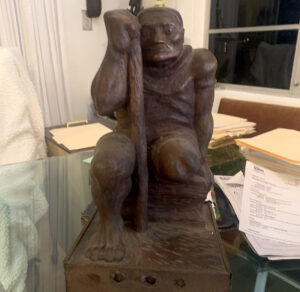 At the Boys & Girls Club, my favorite thrift store in Ventura, I found an ugly Brutalist folk art style wood carving. This one-legged man sits with a cane. For years I searched for the carver. Everyone who comes to my house says it’s the ugliest thing they’ve ever seen. I tend to pick up “orphans”—ugly art from thrift stores with no signatures.
At the Boys & Girls Club, my favorite thrift store in Ventura, I found an ugly Brutalist folk art style wood carving. This one-legged man sits with a cane. For years I searched for the carver. Everyone who comes to my house says it’s the ugliest thing they’ve ever seen. I tend to pick up “orphans”—ugly art from thrift stores with no signatures.
How did I find the artist? Years ago a high school friend leased a flat on Bleecker Street in NYC from a developer who saw the potential in The Village in the 1970s. When developer Ira Weissman died in 2023 my high school friend, who befriended him, inherited a naïve-art woodcarving in the mid-20th century folk-art style carved by Ira. When my friend sent me a photo of this work asking for an opinion of value, the work looked like my ugly thrift store find.
I learned Weissman considered the Swedish sculptor Emil G. Janel (1897-1981) his mentor. Janel, after a long career in California, became known for his Brutalist caricatures in the Scandinavian style of woodcarving. The Maxwell Galleries of the American Swedish Institute, located in the Phillips West neighborhood of Minneapolis, contains thirty-five carving by Janel, donated by Ira Weissman. Bingo. In Ventura I discovered a Swedish style naïve wood folk carving done by a 1920s immigrant to California.
l970s Tradition of Handmade CraftsJanel received the Royal Order of Vasa for his unique technique from the King of Sweden in 1965. He owned a summer house in the 1930s on the Russian River. There he gathered alder wood, which he soaked in a bucket to keep the medium wet. To Janel, wet alder wood seemed like living flesh. The artist termed the slightly grotesque folk art carvings “exaggerated realism.” Janel’s work fits nicely into the l970s tradition of handmade crafts, a direct reversal of austere Scandinavian design, angular and clean, which predates the 1970s crafts revival.
The 1970s revolution in craft and folk art turned away from American mass-produced culture. The art world discovered the true expression of a person was creativity, shown by a handmade work of art. Especially for an artist with no formal training. Remember the early 1970s Isley Brother’s hit: “It’s Your Thing; Do What You Want to Do! I Can’t Tell you Who to Sock it To…”
Museums began to realize ‘artifacts’ and ‘artisans’ were indeed ‘art’ and ‘artists,’ blurring the lines between fine art and craft. For example, the founding of the American Folk Art Museum on Lincoln Square in NYC, dedicated to folk and self-taught artists. Those like the Swedish American Janel, made art as an expression of individuality. A subtle political message lurked behind this movement, eschewing machine-made, post WWII furniture and décor, and turned towards “outsider” art. Unconventionality, as far from mainstream as possible, was imaged as statement of uniqueness.
Non-Educated CreativesThe field of authentic, a difficult term to define, American folk art was only a ‘field’ after the mid-20th century. Self-taught art became synonymous with American individualism, the strong influence from the counterculture and social movements that shaped this decade. The early 1970s began a legacy of respect for non-educated creatives of all kinds (poets, musicians, woodworkers, shaman, dancers) whose craftsmanship, artistic identity, brought ‘craft’ into the broader art world. If not for the ‘self-taught’ revolution of the 1970s thirtysomethings wouldn’t become experts after reading an AI Google search. We trust non-experts because of the “self-taught” revolution of the 1970s!
Many of Janel’s works were sold as “folk,” “outsider,” or “self-taught naïve” art. I notice his human figured sculptures sold in both California and Swedish auction houses in the 2020, as he’s been rediscovered today. Closely resembling my “lame” man, Janel’s “Bodybuilder” is equally imposing, and sold at Toomey Auctions estimated at $1k-2k. An old gentleman perched on a toilet at five inches tall sold for $1,747 in Stockholm Anktionsverk, a dapper but ugly “Gentleman with Walking Stick” sold for $5,250. A carving created in 1922 called “Skalvridning” (twisting the bowl) at eight inches high, showing two-figures holding a massive bowl, sold at Stockholm’s most famous auction venue, Bukowski’s for $8,400.
Thus my “outsider” folk art in the Swedish caricature tradition, found in Ventura at the Boys & Girls Club Thrift Store, is worth $4,000. Ugly, sure, but, to me, interesting and emblematic of the 1970s, weird, folk craftsmanship revolution.
Let me know in the comments below what YOU found in local thrift stores.
The post 1970s Folk Craftsmanship appeared first on Elizabeth Appraisals.
August 3, 2025
Winnie Cheung and Friends
Winnie cheung discusses her show with Nomad Tango, Winnie Cheung and Friends on Sunday, August 3 at SOhO Restaurant and Music Club.
Watch Video

The post Winnie Cheung and Friends appeared first on Elizabeth Appraisals.
July 29, 2025
Overcoming Artist Block
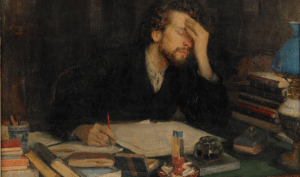 My Montecito artist friend, AWS, experienced the phenomena we call “artist block.” He taught a class to a local Arts Association about ways to overcome “creative block.” He called last week to report the results of teaching that class, and asked me to share his findings with my readers, who, as he said, are no doubt “creatives.”
My Montecito artist friend, AWS, experienced the phenomena we call “artist block.” He taught a class to a local Arts Association about ways to overcome “creative block.” He called last week to report the results of teaching that class, and asked me to share his findings with my readers, who, as he said, are no doubt “creatives.”
What do artists of any medium do when they feel unhappy, and stuck? The illustrated artistic portrayal, “The Passion of Uncertainty” by Leonid Pasternak (1862-1945), shows a writer wrestling with creative block, a reflection of the painter’s own frustration. Pasternak knew how painful “uncertainty” felt. The portraitist fled Russia, then Germany, during WWII. Even so he illustrated Tolstoy’s War And Peace and other Tolstoy novels. He was also the father of Nobel prize winning novelist and poet Boris Pasternak. This painting feels familiar, as I experienced a creative writer’s block recently after the loss of a family member.
Austrian psychologist Edmund Bergler first coined the term “Creative Block” in 1947 to defined that exquisite anxiety when confronting a new canvas, or writing a new work. In my case, pre-writer’s block, I loved to write, well-known author friends recommended “free writing.” Dorothea Brande said in her 1934 book Becoming a Writer:
Write or paint for fifteen minutes each morning—forget about grammar or structure, or composition, and avoid the feeling of commitment to your art—just write, or paint. Do not fear a blank canvas or a white page, and make no corrections.
Beat Generation writer Jack Kerouac, along with Burroughs and Ginsberg, pioneered free-form spontaneous writing.
AWS’s Tips on Overcoming Artist BlockAWS asked his students, “what’s YOUR remedy for becoming unstuck?” AWS reports that many artists fall prey to self-criticism, apathy, resentment, fear of failure, and rigid repetitive negative self-talk. As I said, this topic is dear to my heart. After losing a loved one I only stared at the blank page. Many friends suggested I loosen my thought process. Polling his class, AWS reported ten salient things to overcome “creative block,” remedies for artists who wish to become unstuck—and action plans:
Do the opposite of what you’ve been doing. If you’re working on a large project, do a small one, take it to an uncomfortable place. “Go to an extreme,” my artist friend said, then, “move back to a more comfortable place.”Go as far away from where you are as possible. Leave the house, the studio…. Observe chaos, see how it resolves in the natural order. Such as, in nature, in the waves on a shore, in the waning of the moon. YOU are part of that order. You will win your work back from the uncertainty that you feel.When you feel stuck, remember doubt drives your work. ‘Stuck’ is a part of the discovery of where you will go NEXT.Another artist friend said, “Adversity is your wealth; you don’t need to get rid of this feeling. It’s one of the sources of energy and wisdom.”Ask your best friends about your project. Does this make sense? Are these concepts getting across? How can I improve on this project? Then listen—but don’t always follow the advice.Go see art, listen to poetry or music. Make a mental note that the music or poetry or canvases you saw or heard were at one time new babies. Then write, paint, or compose–put things down…those thoughts are also NEW.Go eat noodles with friends. Be a kid again with trusted folks.Read an artist who soothed themselves through a hard time, such as those poems by Rilke or Browning. Creative people are sensitive and they must KNOW they’re not alone, and need to remind themselves of that fact.When you feel stuck, or stagnant, make circles, draw them until you don’t look at them anymore. Make notes under each circular drawing about how the circle helped you, hypothetically, to get un-stuck…then take a hot bath. Feel as much of the world as fits in one bath, drain it all, dry off—and walk away.Look at Renaissance and Old Master paintings or read some Dante or Chaucer. Remind yourself art and creativity are good, and you, as the creator, need patience, and you’re one of select group in this world.The post Overcoming Artist Block appeared first on Elizabeth Appraisals.
July 27, 2025
19th-Century French Art from the Santa Barbara Museum of Art
Brigette Ginter talks with Eichholz Foundation Director Amada Cruz about the Encore: 19th-Century French Art from the Santa Barbara Museum of Art show on exhibit October 5, 2025 – January 25, 2026.

The post 19th-Century French Art from the Santa Barbara Museum of Art appeared first on Elizabeth Appraisals.
July 22, 2025
Masks of the Zaire Region
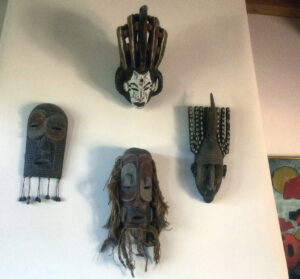 KMcD sent me a photo of four African masks purchased in Tanzania and Kenya, originally from Zaire, the Congo. I love these masks because I spent two years in upper Nigeria and the Ivory Coast with the VSO, the British version of the Peace Corps. I treasure my mask from the Ivory Coast, a wisdom mask, worn by young men at puberty rites. The mask shows a female spirit on the forehead in the shape of a bird that faces downward to the bridge of the nose. Since I raised a male I relate to this mask, acquired in my early twenties, before I became a mother.
KMcD sent me a photo of four African masks purchased in Tanzania and Kenya, originally from Zaire, the Congo. I love these masks because I spent two years in upper Nigeria and the Ivory Coast with the VSO, the British version of the Peace Corps. I treasure my mask from the Ivory Coast, a wisdom mask, worn by young men at puberty rites. The mask shows a female spirit on the forehead in the shape of a bird that faces downward to the bridge of the nose. Since I raised a male I relate to this mask, acquired in my early twenties, before I became a mother.
Only one art form in three dimensions contains many worlds within its shape, color, and design—the mask. Especially in Africa it holds specific symbolic meaning to a specific geographical culture. Before I tell you about the four masks KMcD sent, which date from the 1920s -1930s, I offer my thoughts on their importance.
Cultural and Spiritual Dimension of MasksThe mask offers connection with the ancestors, both on a cultural and spiritual dimension. They’re worn and “danced” as part of the human body, and body politic, at festivals, initiations, funerals, marriages, and in rites of passage such as coming into manhood or womanhood. Masks taught society’s myths, building a common language. The ‘danced’ stories and offered protection against evil, bad luck, and illness, and scare and shame. Masks signaled rank in a community and distinguished one cultural group from another.
In the past Eurocentric history of the world we ‘demoted’ masks to the department of cultural anthropology. Only recently, since 20th century artists like Picasso and Klee, who loved African masks, that we know them as fine art. Without understanding their ritual role, we don’t understand. It’s difficult to describe a “static” mask in a museum case, as it’s NOT “danced” or moved as part of a ritual in action.
For KMcD, I describe the origin of these four masks. From the Eastern BaPende Tribe (Zaire), called “Songye” painted wood masks; some bear dark patinas, and some with white accents of kaolin clay, molded into facial features. One has the original fiber head and chin surround. At least one is recognizable as a mask from the association called “Kifwebe,” a high ranking men’s group in the BaPende community, a group in charge of the community hierarchy and distribution of wealth. One masks is ‘two color,’ distinctive to the BaPende people of today’s Democratic Republic of the Congo. The Pende people, which number 250,000 today, speak a language called Kipende. They have a cultural division in the communities between the Western and Eastern Pende. They’re related to the Bantu Peoples.
Differing From Other Masking CommunitiesThe Pende organize around extended family groups that descend from the matriarchal ancestors. They don’t idolize a king, for example.
Many Pende live in modern day Angola having left the Congo to follow their Queen in 1620. By 1885 European colonists named the region the Congo Free State. In 1930 the People rebelled against the Belgian colonists. So if these masks could speak, and I imagine they do, they’d tell a story of strife from that period 1920-1930s.
Masks of the Zaire region, known traditionally for their inclusion in initiation rituals, also worn to honor ancestors, shaped in male and female forms, some of which were not “danced,” but honored in a static, sculptural (statue-style) forms in a pair in a common sacred area of the village.
Anonymous artists who shaped these ancestor masks became close to the spirit of ancestors. So much so that the community honored them and gave them the first food from the harvest.
Thus spirits became embodied in art. The art became a product of a collective endeavor, then a collective ‘performance.’ When danced, the mask enabled the community to focus on a universal and communal message. The community, their ancestors, their past, was celebrated for thousands of years in ritual. Sadly, the mask’s future after 1930s wasn’t the future these masks wanted welcomed. They were traded as souvenirs.
Value of the four masks combined is $2,000-$3,000 with the possibility of a much higher value in the right market.
The post Masks of the Zaire Region appeared first on Elizabeth Appraisals.
July 20, 2025
Mary Shelley: Year With No Summer
Award-winning novelist and playwright Jule Selbo talks about the world premiere of her play Mary Shelley: Year With No Summer presented by the Ojai Performing Arts Theater August 8-17 at Matilija Auditorium.

The post Mary Shelley: Year With No Summer appeared first on Elizabeth Appraisals.
July 17, 2025
Modernism Philosophy Centered Around Affordable Furniture
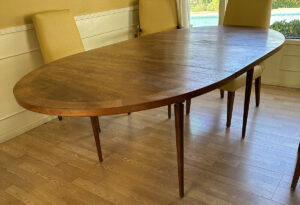 At age twenty I worked as a dancer in Michigan with a touring company of Showboat. I loved the Grand Rapids area. One day off in the late 1970s I toured the Widdicomb Furniture Company’s Museum of Historic American Furniture. They included modern furniture in the display. In their later years, they closed in 2002, Widdicomb affiliated with two of the world’s greatest Modernist designers, George Nakashima (1905-1990) and T H Robsjohn-Gibbings (1903-1976).
At age twenty I worked as a dancer in Michigan with a touring company of Showboat. I loved the Grand Rapids area. One day off in the late 1970s I toured the Widdicomb Furniture Company’s Museum of Historic American Furniture. They included modern furniture in the display. In their later years, they closed in 2002, Widdicomb affiliated with two of the world’s greatest Modernist designers, George Nakashima (1905-1990) and T H Robsjohn-Gibbings (1903-1976).
I remember studying the catalogue at the little museum that defined “modernism in furniture:” a post WWII use of industrial materials for elements in design, the influence of Classical architecture, furniture no longer an “ornament” but “usable,” a focus on “functionality” in the manufacture in use and in total design aesthetic.
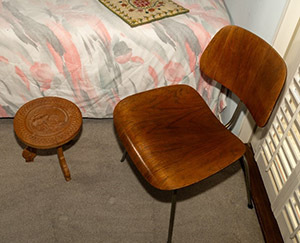 Modernism came closer to a devotedly held elitist religion and philosophy than in any era in the history of design in the past. Although its philosophy centered around non-elite, affordable machine-made furniture. A testament to this new philosophy, that design was/(should be) art. The Museum of Modern Art in the 1930s dedicated a department, Architecture and Design, to furniture and industrial design as well as architecture. Great architect Philip Johnson (1906-2005), who designed in the geometric style, a force for 75 years in the history of the builting environment, headed the department. Among his many achievements, he designed the sparely beautiful Glass House, built between 1949 and 1995, a National Trust Historic Site today, located in New Canaan, Connecticut.
Modernism came closer to a devotedly held elitist religion and philosophy than in any era in the history of design in the past. Although its philosophy centered around non-elite, affordable machine-made furniture. A testament to this new philosophy, that design was/(should be) art. The Museum of Modern Art in the 1930s dedicated a department, Architecture and Design, to furniture and industrial design as well as architecture. Great architect Philip Johnson (1906-2005), who designed in the geometric style, a force for 75 years in the history of the builting environment, headed the department. Among his many achievements, he designed the sparely beautiful Glass House, built between 1949 and 1995, a National Trust Historic Site today, located in New Canaan, Connecticut.
Woodworker George Widdicomb founded Widdicomb in 1858. When George’s four sons enlisted in the Civil War, the little cabinetmaker’s shop dissolved. But when one son returned from war, he opened a furniture shop at a new location in Grand Rapids.
Grand Rapids Becomes Prominent Furniture-Making Hub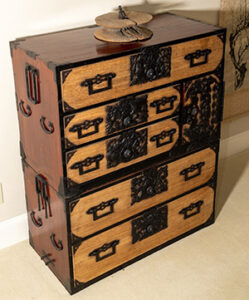 Surrounded by timber forests of pine, walnut, and oak, the Grand River became a prime source for hydroelectric power, creating the US woodworking hub. Soon after the 1890s, the city’s nickname was “Furniture City,” thanks in part to Widdicomb furniture’s growing popularity. In 1891 the company shipped bed frames, chiffoniers, bedroom furniture (mirrors, nightstands, dressers) to far off US cities in various “Revival” styles—far from their modernist look to come!. Revival designs at Widdicomb featured their popular spindle, American colonial with ornately turned wood posts, beds. In those days the style for furniture for the bedroom included two single beds! We see those today at every garage sale.
Surrounded by timber forests of pine, walnut, and oak, the Grand River became a prime source for hydroelectric power, creating the US woodworking hub. Soon after the 1890s, the city’s nickname was “Furniture City,” thanks in part to Widdicomb furniture’s growing popularity. In 1891 the company shipped bed frames, chiffoniers, bedroom furniture (mirrors, nightstands, dressers) to far off US cities in various “Revival” styles—far from their modernist look to come!. Revival designs at Widdicomb featured their popular spindle, American colonial with ornately turned wood posts, beds. In those days the style for furniture for the bedroom included two single beds! We see those today at every garage sale.
America from the 1890-1920s favored furniture that harkened back to previous historic periods. Widdicomb designed in the “Louis XV” French Revival style, the “American Colonial” style, the “English Georgian” style, the “Italian Renaissance” style (think Hearst Castle). John Widdicomb served as the main “Revivalist” designer well into the late 1930s. As the pendulum of design swings, this era that hearkened back to the past changed on a dime to the modernism of the future.
Modernism of the Future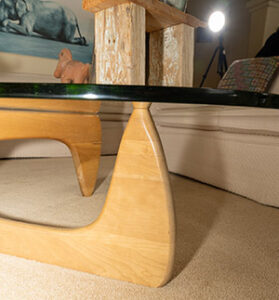 Until the 1940s Widdicomb manufactured traditional styles, until the company hired one of the most sought-after Modern designers of his day, T. H. Robsjohn-Gibbings. Before he came to Widdicomb, he designed houses and furniture for Elizabeth Arden, Neiman Marcus, Doris Duke, publisher Alfred A. Knopf, and Hilda Boldt Weber, for whom he designed Casa Encantada in Bel Air (1934-8). From 1943-56 he worked as lead designer, bringing his signature Grecian (severity) Art Deco classicism to mix with Scandinavian, emphasizing clean craftsmanship/austerity, design. Incompatible, you might think, but reader CM sends me a great example of T. H. Robsjohn-Gibbing’s work, a dining suite in walnut, which artfully blends Grecian lines with Scandinavian craftsmanship.
Until the 1940s Widdicomb manufactured traditional styles, until the company hired one of the most sought-after Modern designers of his day, T. H. Robsjohn-Gibbings. Before he came to Widdicomb, he designed houses and furniture for Elizabeth Arden, Neiman Marcus, Doris Duke, publisher Alfred A. Knopf, and Hilda Boldt Weber, for whom he designed Casa Encantada in Bel Air (1934-8). From 1943-56 he worked as lead designer, bringing his signature Grecian (severity) Art Deco classicism to mix with Scandinavian, emphasizing clean craftsmanship/austerity, design. Incompatible, you might think, but reader CM sends me a great example of T. H. Robsjohn-Gibbing’s work, a dining suite in walnut, which artfully blends Grecian lines with Scandinavian craftsmanship.
The set includes a china cabinet, with the flat, unadorned wood surface featuring Classical tapered feet and drop-brass hardware, more Grecian than Danish. The sideboard is similarly designed as is the table with its classical tapered legs. The dining table includes six chairs, straight-backed, no decoration. The geometry of the furniture speaks for itself, in Minimalist design.
CM Asked About ValueA walnut “X” base dining table from 1943-56, designed by Robsjohn-Gibbings, with similar chairs sold for $5,400 at Rago Auctions, as did a 1949 dining suite in walnut (with label) for $5,600. A pair of dressers, also in light walnut, from the 1950s sold for $2,900.
CM’s suite is in great condition, and lovers of late 1940s early 50s Modernism will likely pay $6,000 for the suite, with its original label crediting Robsjohn-Gibbings. CM may sell. Email me to connect you.
The post Modernism Philosophy Centered Around Affordable Furniture appeared first on Elizabeth Appraisals.
July 13, 2025
Rincon Point
Authors Stephen Bates and Vincent Burns talk about their new book Rincon Point, part of Arcadia Publishing’s best-selling Images of America History Book series.
Watch Video!

The post Rincon Point appeared first on Elizabeth Appraisals.
July 6, 2025
MINDCLAY – A Healing Modality created by Pinter
Dr. Marco Pinter discusses his latest venture, MindClay, which creates mental wellness interventions harnessed beautifully by various art based activities and accessed in the form of an app by its users.
Watch Video
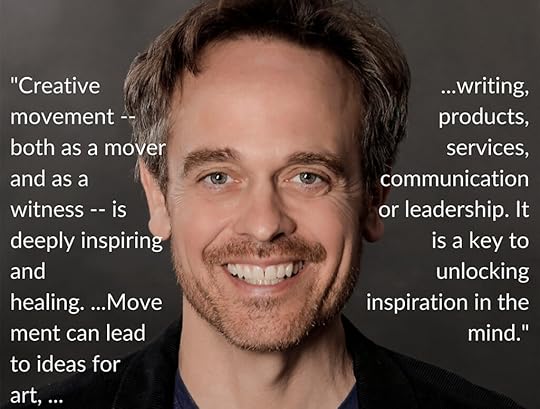
The post MINDCLAY – A Healing Modality created by Pinter appeared first on Elizabeth Appraisals.
Elizabeth Stewart's Blog
- Elizabeth Stewart's profile
- 5 followers



